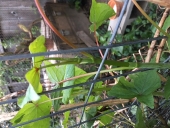Someone in my neck of the woods asked the same question in one of our facebook community groups awhile back, and I posted this response that may be of help to you, too! Most of these will do best/be most productive with at least dappled shade in our area, which usually is pretty warm in the summer (around 80-90F during the day most of the time, sometimes hotter; usually zero rain from June through September).
Oooh, fun! I've done a decent amount of research into shade-loving edibles in the last year, as I've started a new edible garden in my mostly shady front yard. Many of the following plants I haven't eaten yet, but have planted and are doing well so far; from what I understand, most of the fruiting ones will produce more fruit with more sun, but should still be somewhat productive in bright or dappled shade. Here's a list of what I've got planted:
Mint
Raspberries
Thimbleberries (a raspberry relative, native to the Pacific coast)
Rubus calycinoides (a groundcover-type raspberry, no thorns)
Lemon balm
Horseradish
Asparagus
Aronia melanocarpa (grown for its berries)
Gaultheria shallon (also called "salal"- a native grown for its berries)
Gaultheria procumbens (aka wintergreen, another native grown for its berries which yes, definitely taste of wintergreen! and for its leaves, which can be used to make a tea)
Arctostaphylos uva-ursi (aka kinnikinnick, a native grown for its berries)
Lonicera caerulea (also called honeyberry or haskap, grown for its sweet blue berries)
Viburnum trilobum (aka highbush cranberry)
Gooseberries
Currants
French sorrel (I've grown this with huge success in bright shade for years!)
Huckleberries
Violas (for their edible flowers)
Calendula (for their edible/medicinal flowers)
Turkish rocket (a perennial broccoli relative - this is growing quite well in partial shade in my yard!)
Good King Henry (a perennial spinach relative)
Mashua (a nasturtium relative grown for its edible tubers; I grew this last year in partial shade with great success)
Malabar spinach (a perennial, semi-vining green, somewhat frost tender)
Oregano (does *great* in partial or dappled shade!)
Thyme
Yerba buena (a native mint relative; does fine in even full, bright shade)
Alpine strawberries (grow these in the brighter areas for best fruiting)
Rhubarb
Catnip
Kale/lettuces/arugula/other greens
Claytonia (aka miner's lettuce; a delicious native springtime green in our area)
Stinging nettles
Cornus mas (an edible-fruiting dogwood tree)
Allium triquetrum (a wild onion that grows like crazy around here in the spring)
Cow parsnip (a native parsley relative with edible stems)
Aralia cordata (aka Udo, a large shade-loving shrub used like asparagus in the spring)
Polygonatum odoratum (a beautiful, fragrant shade lover, with apparently edible shoots and roots, though I've never eaten them)
Asarum caudatum (aka wild ginger, native shade plant used for ginger-like roots, apparently toxic in large quantities)
Pawpaw trees (*not* papaya, but Asimina triloba, a native to the eastern U.S. I put in a few last year to try, and which are doing quite well so far)
Camellia sinensis (used to make green and black tea)
Celery does decently in partial shade, and apparently its perennial relative, skirret (grown for its carrot-like roots) does, too
Hosta (edible shoots in the spring)
Medlar (an apple relative to about 6 ft tall, apparently does well in partial shade)
My quince tree has been doing well in partial shade for 7 years!
A few I haven't tried yet, but want to add to my yard:
Matteuccia struthiopteris (aka Ostrich fern, used for fiddlehead ferns)
Allium tricoccum (aka ramps)
Allium ursinum (bear's garlic)









